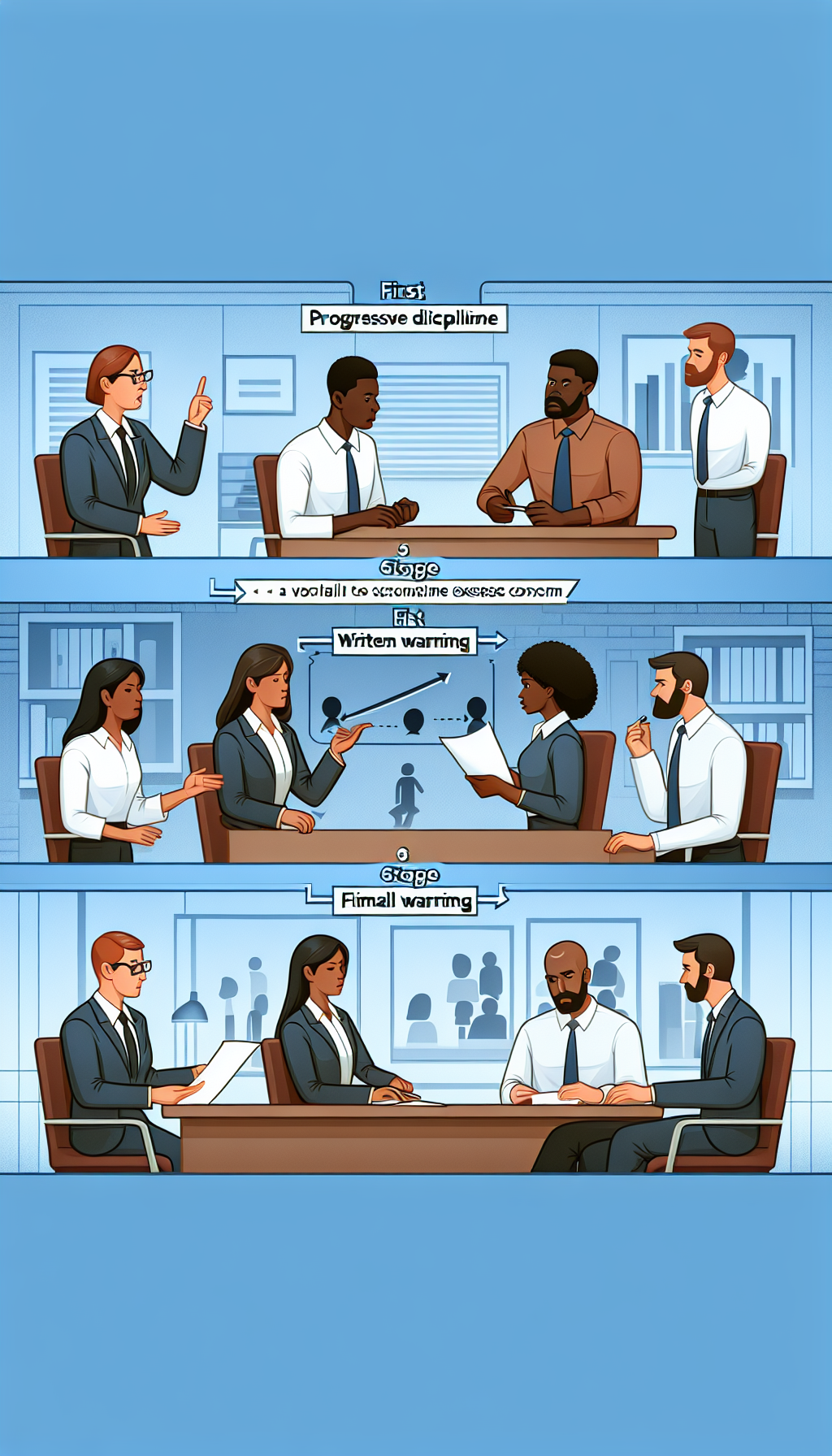Progressive Discipline Policy – Samples Below

The progressive discipline policy is generally utilized by managers/supervisors to call to attention, employees who have violated the behavioral code of the organization, i.e., Tardiness, Absenteeism, Insubordination, Disrespectful Behavior, Misconduct, Theft, Fighting, Sexual Harassment, Discrimination, etc. The core purpose of a progressive discipline policy proceedings against an employee is not so much to penalize and punish the employee but to help them remedy their behavior till all such issues have been successfully resolved. A progressive discipline policy in effect is a handy tool that provides managers/supervisors with an approach that is both transparent and fair along with being consistent as well. This tool, if used correctly, not only helps management handle all behavioral related problems but also safeguards the lawful rights of both employers and employees. It typically includes a pre-determined series of gradually increasing formal steps. Including but restricted to verbal counseling’s, written warning documents, and if all else fails, finally a complete dismissal from his/her employment.
Progressive Discipline Policy - “Just Cause” Standards

Before taking any severe measures, the progressive discipline policy process has to include certain standards. At its simplest the near universal concept of Just Cause denotes “a reasonable and lawful grounds for action.” In other words, it’s a standard of “reasonableness” that is used to assess an employee’s behavior (in the context of employer/employee relationships”) within specific circumstances. “
As per American labor practices there is a standard of seven factors that are used to determine Just Cause in the labor and employment context
The employee knew of the company’s policy
Example
A worker violates the company policy regarding profanity that is part of the employee manual. Nevertheless, he persists in using the same in spite of multiple oral and written warnings, then it may be grounds for disciplinary action.
The company’s policy was reasonable
Example
The employee had not only read the manual but also signed the joining documents in which profanity was classified as a serious offense.
The organization carried out an investigation to determine that the employee was in violation of the policy.
Example
The charges against the employee were confirmed after a fair investigation that included interviewing witnesses and witness statements.
The investigation was fair and objective
Example
There was no element of ‘railroading’ or favoritism and the employee was given ample opportunity to defend his action.
Substantial evidence existed of the employee’s violation of the policy
Example
In the case of theft of company property, CCTV footage of the employee was captured while he was actually committing the crime
The company’s policy was consistently applied
Example
The policies have to be the same for every employee irrespective of the level of his seniority.
The discipline was reasonable and proportional to the offence (i.e. the punishment fit the crime)
Example
The employee using swear words was suspended without pay for a week, while the worker who stole company property was terminated from service.
The Major Components in a Progressive Discipline Policy Process
Should Include:

The standards applicable to a progressive discipline policy
All disciplinary actions should have an element of fair play. If there is any inherent bias and favoritism in applying the standards as enshrined in the employee manual, it would leave the organization open to charges of ‘unfair practices.
Fact Finding
As the term implies fact finding investigates the causes of the employee’s behavioral issues. The purpose is not to pass judgments but merely to establish the facts of the employee’s behavioral situation that has presented itself. Typically, the process would be to speak directly with all those involved in the issue. In addition, to the employee it may include any witnesses. Use caution when involving any other employees who may be a witness to the situation since this can violate the offender’s confidentiality if you are not sure they have information helpful in determining the facts, i.e., don’t question employees just to question them. The other important part of the fact-finding process is to not correct the employee during your questioning since this may be perceived as discipline and negate something further you intend to issue in writing if you have determined the employee clearly violated your policy, i.e., ask questions and listen to the answer closely and then move on to the next question without commenting on the answer you just received.
As an example, if an employee has violated your tardiness policy you may ask the following questions:
1. Why are you late? They may answer – I missed my ride.
2. Why did you miss your ride? They may answer – I woke up late.
3. Why did you wake up late? They may answer – I didn’t hear my alarm clock.
4. Why didn’t you hear your alarm clock? They may answer – I didn’t get to bed until really late.
5. Why didn’t you go to bed earlier? They may answer – I was up late studying for my final exam. I am attempting to get my Master’s Degree.
This line of questioning may bring you to a completely different conclusion than you may have thought you would reach before your questioning. Now this probably will not be the typical set of answers but it gives you an idea of why we go through the fact-finding process. You may still issue a written counseling even if this was the answers so that you establish that although you endorse getting a good education it is equally important that they follow your policies, such as, notifying you in advance of the start of their shift.
Fairness
The most important part of the progressive discipline policy process is to make sure it is fair based on facts and not feelings. Therefore, before taking any progressive disciplinary action you should ask yourself if it is fair. As per American labor practices there is a standard of seven factors that are used to determine Just Cause in the labor and employment context
1. The employee knew of the company’s policy
2. The company’s policy was reasonable
3. The organization carried out fact finding to determine that the employee was in violation of the policy.
4. The fact-finding session was fair and objective
5. Evidence existed of the employee’s violation of the policy
6. The company’s policy was consistently applied
7. The discipline was reasonable and proportional to the offence (i.e. the punishment fit the crime)
Types of Disciplinary Actions

Verbal Warning
Often times a supervisor/manager will have a conversation with an employee who just violated a policy established by the company. The conversation may include language like “John, it is critical that you show up on time. Tardiness is not allowed. If you are tardy again, I may have to take action based on our progressive discipline policy.” In order to memorialize this conversation, you may want to send an email to the employee (John) confirming the conversation you just had. The email may read something like this: John, this is to confirm that we spoke about your reporting to work late on June 1, 2016, tardy. I informed you that this is not allowed and if it happens again you may subject to our progressive discipline policy. Now you have a written record of the conversation.
Written Counseling/Written Warning
This is exactly what it appears to be. It is a more formal written record of the poor behavior and violation of the company policy. It establishes a pattern that you are warning the employee that they have violated the company policy and if they continue to violate any of your company policies, they may receive additional discipline up to possible termination.
Dos and don’ts of written counseling/warning letters
Dos
1. State the problem due to which the warning has been submitted
2. Refer to previous discussion (the single or multiple oral warnings that have already been issued)
3. While drafting the warning letter state the specific actions that are needed for rectification of the objectionable conduct or lack of performance
4. Indicate in the first paragraph of the letter that it represents the commitment of formal disciplinary action procedures and the level of its warning (i.e. if it’s a first or a last warning)
5. The warning letter should explain to the employee without any ambiguity, the penalties that would be incurred due to continue under performance and/ or lack of improvement in behavioral problems. (These could also include dismissal from service)
6. Signature and date lines that the employee would have to sign both on original and duplicate copies that would be part of his employment record.
7. Try to be specific without meandering into useless discourses that are beyond the scope of the warning letter.
8. Do state what policy the employee violated. Whenever possible make it a point to attach a copy of the policy that has allegedly been violated.
9. Make it a point to indicate precisely why the violation is harmful to the organization. (By providing this context, you would be able to clarify, why an otherwise seemingly innocuous violation may have grave consequences. A point that may not be obvious to everyone involved and would help the offender realize the gravity of his error)
10. Provide clear worded and specific instructions on how the employee can improve with the help of concrete suggestions.
11. Do issue reprimands consistently irrespective of the position of the violator. This will help ensure that all concerned are to be held to the same standard.
12. Follow up on the Written Counseling/Warning letter in order to see what effect it has had on the employee’s behavior or performance.
Don’ts
1. The Warning letter should be devoid of personal remarks, accusations or medical opinions.
2. Don’t issue written warning or serious penalties such as demotion or dismissal without performing a fair fact-finding session.
3. Under no circumstances should any warning or penalty letter (such as suspension, demotion, termination etc.) or its duly acknowledged receipts be lost. It must always be remembered that a lost document is a document that has never existed in the eyes of the law.
4. Don’t forget to put in an employee signature line. "It’s imperative that the organization made every attempt possible to get the employee to sign off his penalty/reprimand.” However, if he steadfastly refuses to sign it make sure that you note it down on the reprimand/punishment letter and get the signatures of the two aforementioned witnesses to the act of refusal.
Following these’ Dos and Don’ts’ of documentation guidelines while initiating or administering disciplinary action against offending employees would not be a complete shield against any subsequent lawsuits filed by the disgruntled employee. However, it will help ensure that should the need arise employers will be better equipped in the event an employee decides to file a law suit or take some other form of action like file an EEOC complaint or unemployment claim.
Suspension Without Pay
Suspensions without pay are generally awarded for behavioral issues rather than performance related issues. The period of suspension may vary from a single day to months, depending on the severity of the offense. In some cases, an employee may be suspended (such as sexual abuse/assault cases or theft cases) pending the outcome of the investigation. If he were to be exonerated, he could be re-instated with back benefits.
Blocking of Promotion
If an employee is due for promotion, he may have his promotion blocked due to his lack of performance or behavior issues. Such a block on promotion may continue indefinitely as per the discretion of the management.
Example:
Mr. James is an assistant marketing manager at ABC pharmaceutical company and was due to be promoted to marketing manager after his next appraisal, but after he was involved in a verbal fight with another staff member, his promotion was blocked for the duration of that year.
Blocking increments and bonuses
Increments
This form of punishment is typically used for both performance related issues as well as behavioral offences. The employee may have his annual increments curtailed or out rightly blocked for a pre-specified period of time that may be increased by the management if and when it deems fit. Usually, such penalties are awarded for a one-year period and periodically reviewed. If the worker’s performance does not improve the block is extended till the time it does.
Bonuses
A ‘bonus’ is awarded to an employee over and above his salary when his work has proved to be of such extra value that it deserves recognition by the management to ensure the individual is sufficiently motivated to continue to work with the same enthusiasm. When it comes to underperforming employees, such bonuses are almost never awarded to the worker since he is not even able to maintain the standards to justify his own salary let alone any extra rewards (Cash or otherwise). However, in the case of a well performing employee who has to be penalized for objectionable behavior, the removal of the bonus he has earned is considered a good enough form of censure to motivate him to rectify his behavior. Some organizations may, (if they consider the individual important enough that is) give him the bonuses that he had accrued during the period he was penalized. These are supplemental to the fresh bonuses he may have earned after he had corrected his behavior.
Demotion
Next to outright termination this is considered one of the most severe punishments that an employer/ organization could award to its employee(s). Provided the due process has been conducted (and in case of behavioral problems) the employee has been found guilty or in the case of lack of performance that could not be rectified, in spite of a performance employee plan and multiple warnings both written and oral, the employee may lose his seniority and be demoted to any rank below his own. It may be a single step downgrading or multiple steps.
Demotions generally show the management’s extreme displeasure with an employee and are sometimes a prelude to outright termination. If terminations may prove very difficult demotions are used to inform the employee that they are really not wanted and should opt to resign on their own. It is considered a very drastic measure since it means a loss of dignity, respect, power and status of the employee and would severely de-motivate him and hamper his subsequent productivity.
Example 1
A regional sales manager who consistently fails to meet his targets may be demoted to assistant sales manager or even sales executive.
Termination/Dismissal
The final step would be the irreversible termination of the worker’s employment. This step should be a last resort and only to be undertaken if the employee has failed to live up to the standards of the organization. Every step of the progressive discipline policy process would clearly elucidate the penalty for failure to take responsible corrective action. Moreover, all documents issued to him should have copies duly acknowledged and signed by him, placed in his personal file as maintained by leadership.
